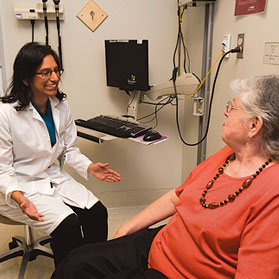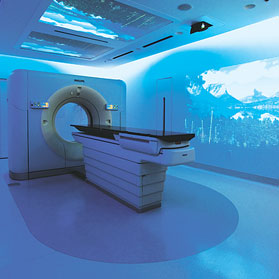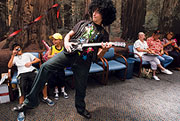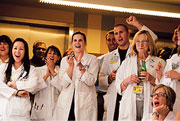Connections: Motivated and moving forward
 Because the medical community has so little experience with this cancer, a UC Davis team immediately formed to conceive the best course of action. Jyoti Mayadev, assistant professor in the UC Davis Department of Radiation Oncology, came on board to oversee the radiation therapy component of the treatment plan.
Because the medical community has so little experience with this cancer, a UC Davis team immediately formed to conceive the best course of action. Jyoti Mayadev, assistant professor in the UC Davis Department of Radiation Oncology, came on board to oversee the radiation therapy component of the treatment plan.
"There are no standard guidelines to follow for such an unusual cancer," says Mayadev. "Mrs. Foscarini’s gynecologist, Anne Rodriguez, and I started to plan her treatment course very early, before her surgery and before I even met Mrs. Foscarini."
Mayadev was recruited last year to the Department of Radiation Oncology for her expertise in the management of women with gynecological and breast cancers. She believed that the best course for Foscarini after surgery would encompass externally delivered radiation – the ordinary path followed when getting an X-ray – as well as brachytherapy, in which a source of radiation is placed inside the body. Brachytherapy enables more direct delivery of rays to a targeted tumor.
Mayadev is one of several radiation oncologists who have joined the department in recent years. Modernized with new state-of-the-art equipment, the department has burgeoned under the leadership of Richard Valicenti, hired in 2009 as chair. Valicenti quickly set about assembling a professional team composed of some of the best young minds in the country, as well as acquiring the newest and most powerful tools available in radiation oncology.
"My goal has been to form a department with subspecialists in the major areas of cancer – doctors who are at the forefront of their specialty and who are able to deliver innovations and the highest standard of care to our patients," he says.
 "My patients are my inspiration. It is very motivating to try to find ways to extend survival and offer a better quality of life for some of these devastating diseases."
"My patients are my inspiration. It is very motivating to try to find ways to extend survival and offer a better quality of life for some of these devastating diseases."
Valicenti’s efforts have paid off. The UC Davis Medical Center radiation oncology department has become one of the premier facilities in the country, with a dynamic staff and modernized quarters that could double for a space-age Hollywood set. The busy department serves 60 to 80 patients a day, and has three dedicated radiation machines capable of delivering high-precision radiotherapy.
Valicenti has emphasized creating a team that takes a multidisciplinary approach to patient care. The remodeled department contains a large work space where doctors and technicians can meet together at computer stations to plan therapy. According to Valicenti, everyone in the department works closely together to develop treatment plans, which can be incredibly complex.
"For every hour we spend face-to-face with a patient, we probably spend 20 to 30 hours planning his or her therapy," he says.
 "Garnering a team with each member having expertise in a certain speciality area has been critical to maximizing use of the important innovations now available in cancer treatment."
"Garnering a team with each member having expertise in a certain speciality area has been critical to maximizing use of the important innovations now available in cancer treatment."
The field of radiation oncology has developed exponentially in recent decades as technological advances in imaging, mapping and radiation delivery have spurred each other’s progress. Using sophisticated computer modeling programs, doctors can map and shape the delivery of radiation so that a tumor’s location can be precisely identified, accounting for changes of tumor size and shape during the course of therapy and even taking into account changes of position during breathing. Computer-controlled linear accelerators deliver varying radiation doses to multiple points, "sculpting" the radiation three-dimensionally to fit the tumor. High-intensity radiation beams can be delivered to small areas with little scatter, allowing for knife-like precision in destroying a tumor and avoiding damage to surrounding healthy tissue.
"The capabilities of radiation oncology today are phenomenal," Valicenti says. "Garnering a team with each member having a specialized expertise in a certain area has been critical to maximizing use of the important innovations now available in cancer treatment."
Research is another important component of the department. Each specialist has a particular research interest, and being a part of an academic center constantly promotes innovation.

"The large patient volume and the opportunity to treat unusual tumors such as Mrs. Foscarini’s puts us in a unique position to conduct innovative clinical trials, especially ones that have the potential to lead to rapid clinical applications," says Valicenti, who is involved in a trial studying treatment of bone metastases from prostate cancer. "Participation in clinical trials also offers our patients access to promising therapies that are not available otherwise."
Despite the high-tech, ultra-modern feel to the facility – or maybe because of it – staff members pay particular attention to making patients feel comfortable. One treatment planning room has a wall and ceiling lined with screens hooked up to a selection of relaxation videos geared toward children or adults. Patients can watch Alpine scenery, waving palm trees or cartoon fairylands while they undergo a radiation therapy planning session, typically 30 to 40 minutes long.
"The videos were very helpful," says Foscarini, who also appreciated the background music. "I once told the technician that I’m of the age that enjoys Elvis, and the next day they had Elvis playing for me!"

Foscarini required daily intensive radiation treatment for six weeks, followed by a few more weeks of twice-weekly treatment.
"Everyone – from Dr. Mayadev and the other doctors to the technicians and receptionists – made me feel like family," she adds. "Although the reason I was getting treatment was certainly not positive, I actually looked forward to coming in."
Valicenti, who is rightfully proud of the transformed radiation oncology department, concurs that many components are essential to building a successful treatment facility – state-of-the-art equipment, expertise in different specialties, teamwork, and caring for patients’ needs.
"We never lose sight of our primary goal," says Valicenti, "to provide innovative cancer therapy with optimal care, maximizing longevity with the highest possible quality of life."













